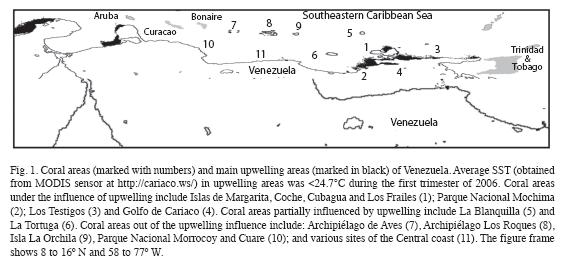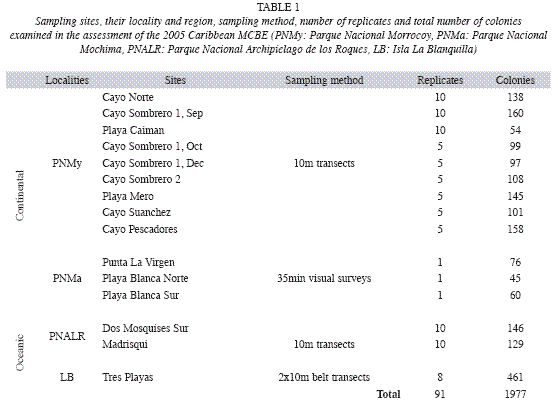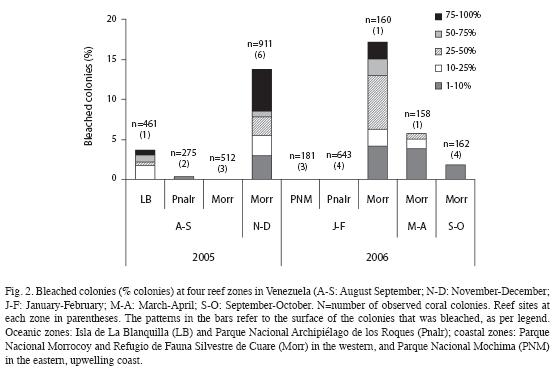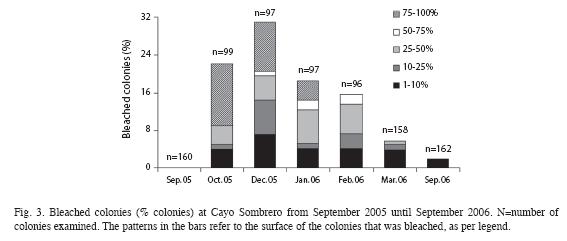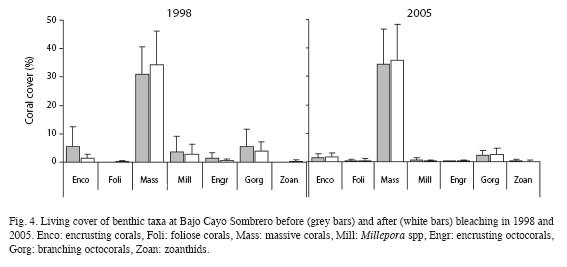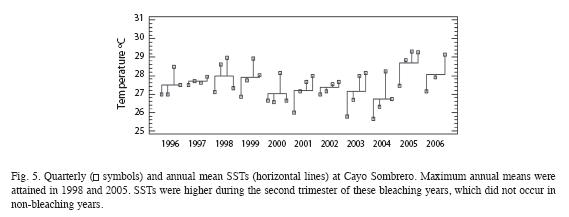Services on Demand
Journal
Article
Indicators
-
 Cited by SciELO
Cited by SciELO -
 Access statistics
Access statistics
Related links
-
 Similars in
SciELO
Similars in
SciELO  uBio
uBio
Share
Revista de Biología Tropical
On-line version ISSN 0034-7744Print version ISSN 0034-7744
Rev. biol. trop vol.58 suppl.3 San José Oct. 2010
Sebastián Rodríguez1*, Aldo Cróquer1,3, David Bone1,2 & Carolina Bastidas1,2
1. Instituto de Tecnología y Ciencias Marinas.
2. Dept. Biología de Organismos.
3. Dept. Estudios Ambientales. Universidad Simón Bolívar. Caracas 1080-A, Venezuela.Abstract
Key words: coral reefs, stress, global warming, bleaching.
Resumen
En este estudio se describe la severidad del evento de blanqueamiento del 2005 en 15 arrecifes coralinos de Venezuela, y se compara con el ocurrido en 1998 para uno de esos arrecifes. Los primeros corales blanqueados se observaron en agosto y septiembre 2005, en arrecifes oceánicos en lugar de costeros, afectando entre 1 y 4% de las colonias coralinas (3 arrecifes, n= 736 colonias). Para ese momento, tampoco se había detectado blanqueamiento en áreas oceánicas de la costa este de Venezuela (3 arrecifes, n= 181 colonias), donde ocurre una surgencia estacional. En arrecifes costeros, el blanqueamiento comenzó en octubre pero alcanzó su máximo entre noviembre 2005 y enero 2006, afectando hasta el 16% de los organismos de una variedad de taxa (e.g. escleractinios, octocorales, Millepora, zoántidos). En los hábitats de Acropora de Los Roques, no se observó blanqueamiento en el 2005 (4 sitios oceánicos, n= 643 colonias). En Cayo Sombrero, un arrecife costero, el blanqueamiento fue menos severo en 1998 comparado con el de 2005 (9% de colonias coralinas de 2 especies vs. 26% de colonias de 23 especies, respectivamente).Estos resultados indican que el blanqueamiento del 2005 fue más severo que el de 1998 en los arrecifes de Venezuela, sin embargo, no ocurrió mortalidad masiva asociada a ninguno de los dos eventos.
Palabras clave: blanqueamiento, arrecifes, cambios comunitarios, calentamiento global.
The 1990s were perhaps the worst decade for coral reefs, with at least three (1990, 1995 and 1998) destructive MCBEs being recorded along the Great Barrier Reef (Berkelmans & Olivares 1999, Baird & Marshall 1998) and in the Andaman Sea, Thailand, French Polynesia and the Caribbean (Lang 1990, Brown 1997, Aronson et al. 2002). After the 1998 MCBE, only background bleaching (i.e. very few colonies showing bleaching signs) was reported. In 2005, however, a new MCBE was recorded affecting corals and other sessile organisms in the Caribbean. Early reports started in the Caribbean during August 2005 and continued throughout January-March 2006 in other bioregions (see the coral list).
Coral bleaching occurs when physiological thresholds are exceeded, disrupting the coral-zooxanthellae association. While prolonged and intense sea surface temperature anomalies (SSTA) have been correlated with massive bleaching events (Buddemeier & Fautin 1993, Brown 1997, Hoegh-Guldberg 1999), other stressors such as a high incidence of UV, changes in salinity, etc., also trigger the expulsion of zooxanthellae from their hosts (Douglas 2003, Glynn & D´Croz 1990), the loss of zooxanthellar photosynthetic pigments and/or structural damages due to oxidative stress (Lesser 1997, 2004). In 2005, a prolonged and intense SSTA occurred across the Caribbean for over six months resulting in extensive bleaching across the region.
Despite the 2005 MCBE being considered the most intense ever recorded in the Caribbean, assessments of its temporal and spatial variability and its magnitude are scarce and/ or anecdotal. In this study, we assessed the severity (i.e. percentage of corals and other reef organisms pale or bleached) and the intensity (i.e. percentage of surface area pale or bleached in a colony) of bleaching at 15 reef sites located across the Venezuelan coast, at oceanic islands and in upwelling zones. In Cayo Sombrero, we also monitored bleaching for 18 months and compared the severity of the 1998 and 2005 MCBEs.
Materials and methods
In order to assess the spatial variability of the 2005 MBCE, the percentage of bleached organisms on reefs was estimated at 15 sites located at four localities (Fig. 1): two oceanic (Los Roques National Park [LRNP] and La Blanquilla [LB]) and two coastal (Mochima and Morrocoy National Parks). At each locality, the percentage of corals, octocorals and zoanthids (185-715 colonies per locality) showing signs of bleaching (i.e. partial or total loss of color) was quantified. We also estimated the intensity of the bleaching event by quantifying the relative percent of the surface affected by bleaching in each colony. For this, five qualitative categories were used in the field: 1-10%, 11-25%, 26-50%, 51-75% and >75% of the colony area affected. Sites were assessed during opportunistic expeditions, thus the sites differ in the methods used and the number of replicates (Table 1). Eleven out of the 15 surveys were done by determining the bleaching status of each coral colony (or any other zooxanthellate benthic organism) encountered below a 10m chain transect. Three of the surveys were done by annotating the bleaching status of coral colonies encountered in a free swimming period of 35 minutes; and in one survey this was done using a belt transect of 2x10m (Table 1). Since surveys were conducted during different months at different reef sites, results were grouped into the following periods: (1) August-September 2005, (2) November-December 2005 and (3) January-February 2006.
Results
Coastal coral reefs off Morrocoy on the western coast of Venezuela started to bleach in November-December 2005 and affected 14% of the colonies (6 reef sites, n=911). Here, bleaching intensity also increased within this period, with more than 5% of corals manifesting >75% of surface bleaching (Fig. 2). By the end of January-February 2006, the bleaching at Morrocoy had extended to 14-17% of the colonies but the percentage of corals severely bleached was reduced from 5 to 2% (Fig. 2). At this time, colonies of Acropora palmata were not bleached at either of the two sites at LRNP; however, 1-10% of the colonies of Montastraea faveolata were bleached in deeper areas of these reefs (n=643).
By March-April 2006, less than 6% of the corals at Morrocoy were bleached and in 3% of them (n=158), bleaching was not intense and only 1-10% of the total colony area was affected. Bleaching severity steadily decreased from April to October 2006, with less than 2% of the colonies (n=162) showing bleaching by the end of this period (Fig. 2).
Comparison of the 1998 and 2005 MCBEs: The reef site at Sombrero was affected by MCBE in 1998 and 2005. In both cases, the peak of bleaching occurred during the last trimester of each year. However, during 2005 the percentage of bleaching (26%, n=196) was three-fold higher than in 1998 (9.4%, n=160). Furthermore, during 1998, only two massive scleractinian genera were bleached:
Montastraea (8.7%) and Colpophyllia (0.6%), whereas during 2005, seven species including massive, foliaceous and encrusting corals were bleached. Also, at least two species of octocorals and zoanthids were affected by bleaching in 2005. Few months after the peak of stress of both, the 1998 and 2005 MCBEs, bleached colonies recovered in Sombrero and no important changes in the community structure of this site were detectable (Fig. 4).
Discussion
Either the length of exposure to, or the severity of, a given temperature stress or anomaly might result in coral bleaching (Glynn & D´Croz 1990). Bleaching has been observed either when corals are subjected to sharp (1-2°C ) increases in SST over short periods (i.e. few days) or when temperature moderately increases (0.5°C) for longer periods of time (Glynn & D´Croz 1990). A comparative analysis of SSTA and the patterns of coral bleaching in the Caribbean in 2005 show that this event could have been caused by the combination of prolonged (>6 months) exposure to elevated sea water temperatures (an increase of 2-2.5°C above the mean). Likewise, the 1998 MCBE was correlated with intense and prolonged SSTA for that year.
Coral bleaching has been often linked to coral reef decline in Latin American and Caribbean coral reefs (Cortés 2004). While major bleaching events in the Caribbean have been recorded during ENSO years (1982-1983, 1988-1989), other bleaching events have been reported during SSTA not associated with ENSOs (1995, 1997, 1998-1999). Previous major bleaching events associated with ENSOs produced extensive bleaching and a subsequent significant reduction of coral cover (10-70%) across the Caribbean (e.g. Panama, Belize, Costa Rica, Colombia and Venezuela, hmong others) and affected a broad range of species, especially Agaricia spp., Millepora spp. And the Montastraea species complex (Lasker et al. 1984, Lang et al. 1992, Fitt et al. 1993, CARICOMP 1997b, Guzmán 2003, Gibson & Carter 2003, Cortés & Jiménez 2003, Garzón-Ferreira & Díaz 2003, Weil 2003).
In Venezuela at least two SSTAs were recorded at Sombrero during 1998 and 2005: (1) mean annual temperatures in 1998 and in 2005 were above those in previous years when bleaching was not recorded and (2), SSTs were higher during the second trimester of these bleaching years, which did not occur in non-bleaching years (Fig. 5). Furthermore, the thermal anomaly recorded in 2005 was more intense than the one of 1998 (Fig. 5), which explains why the bleaching event in 2005 was more severe than in 1998. Thus, our results support studies that have evidence for a causal relationship between ocean warming and bleaching, although other factors could be involved (see Introduction). As in 1995 and 1998, in Venezuela the peak of bleaching in 2005 was less intense and severe than in other areas in the Caribbean and lagged behind that elsewhere in the region (Wilkinson & Souter 2008). This result suggests that MCBEs in the southern Caribbean normally occur two-three months later (October-November) than in other areas in the region (July-August in 1998 and 2005). A lower intensity of thermal stress in the southern Caribbean might explain this pattern. For instance, in Venezuela, the maximum SST recorded in 1998 was 29.2ºC, whereas in the western and the northern Caribbean SST reached 29.7 and 30.2ºC, respectively (Sheppard & Rioja-Nieto 2005).
In conclusion, the 2005 MCBE affected oceanic reefs of Venezuela two months before coastal reefs; however, bleaching was more intense and severe in the latter (west coast of Venezuela, Morrocoy). Coral reefs located on the east coast of Venezuela, which are normally subjected to upwelling (SST=23°C in January 2006), were not affected by the 2005 MCBE compared to non-upwelling areas (SST>27°C in January 2006). The MCBE in 2005 was more severe and intense than in 1998, affecting a wider range of marine organisms at higher intensity.
Acknowledgments
We would like to thank all the personnel that have been involved in the CARICOMP program in Venezuela and particularly to INTECMAR-Universidad Simón Bolívar for its full support since this program began. We are also grateful to the comments by P. Sammarco and two anonymous reviewers that help improving this manuscript.References
Aronson, R.B., W.F. Precht, M.A. Toscano & K.H. Koltes. 2002. The 1998 bleaching event and its aftermath on a coral reef in Belize. Mar. Biol. 141: 435-447. [ Links ]
Baird, A.H. & P.A. Marshall. 1998. Mass bleaching of corals on the Great Barrier Reef. Coral Reefs 17: 376. [ Links ]
Berkelmans, R. & J.K. Oliver. 1999. Large-scale bleaching of corals on the Great Barrier Reef. Coral Reefs 18: 55-60. [ Links ]
Buddemeier, R.W. & D.G. Fautin. 1993. Coral bleaching as an adaptive mechanism. BioScience 43: 320-326. [ Links ]
Hoegh-Guldberg, O. 1999. Climate change, coral bleaching and the future of the worlds coral reefs. Mar. Freshw. Res. 50: 839-866. [ Links ]
Lang, J.C., H.R. Lasker, E.H. Gladfelter, P. Hallock, W.C. Jaap, F.J. Losada & R.G. Muller. 1992. Spatial and temporal variability during periods of "recovery" after mass bleaching on western Atlantic coral reefs. Amer. Zool. 32: 696-706. [ Links ]
Muscatine, L. 1990. The role of symbiotic algae in carbon and energy flux in coral reefs. Coral Reefs 25:75-87. [ Links ]
Rodríguez-Ramírez, A., C. Bastidas, S. Rodríguez, Z. Leão, R. Kikuchi, M. Oliveira, D. Gil, J. Garzón- Ferreira, M.C. Reyes-Nivia, R. Navas-Camacho, N. Santodomingo, G. Díaz-Pulido, D. Venera-Ponton, L. Florez-Leiva, A. Rangel-Campo, C. Orozco, J.C. Márquez, S. Zea, M. López-Victoria, J.A. Sánchez & M.C. Hurtado. 2008. The effects of coral bleaching in Southern Tropical America: Brazil, Colombia, and Venezuela, p. 105-114. In C. Wilkinson & D. Souter (eds.). Status of Caribbean Coral Reefs after Bleaching and Hurricanes in 2005. Global Coral Reef Monitoring Network, and Reef and Rainforest Research Centre, Townswille, Australia. [ Links ]
Sheppard, C. & R. Rioja-Nieto. 2005. Sea surface temperature 1871-2099 in 38 cells in the Caribbean region. Mar. Environ. Res. 60: 389-396. [ Links ]
Wilkinson, C. & D. Souter (2008) Status of Caribbean Coral Reefs after Bleaching and Hurricanes in 2005. Global Coral Reef Monitoring Network, and Reef and Rainforest Research Centre, Townswille, Australia. [ Links ]
Correspondencia: Sebastián Rodríguez. Instituto de Tecnología y Ciencias Marinas.Aldo Cróquer. Instituto de Tecnología y Ciencias Marinas. / Dept. Estudios Ambientales. Universidad Simón Bolívar. Caracas 1080-A, Venezuela.
David BoneInstituto de Tecnología y Ciencias Marinas. /Dept. Biología de Organismos.
Carolina Bastidas. Instituto de Tecnología y Ciencias Marinas. / Dept. Biología de Organismos. Universidad Simón Bolívar. Caracas 1080-A, Venezuela.













